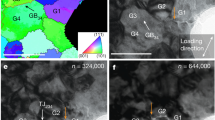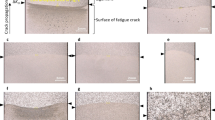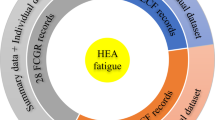Abstract
A PARAMETER often used for correlating the propagation rate of fatigue cracks is the stress intensity factor K. This follows the work of Irwin1, who showed that the elastic stresses at a point near the root of a crack always have the form  where r and θ are polar co-ordinates, with the origin at the crack tip, of the point. The expression is only valid if r≪a (the crack half length).
where r and θ are polar co-ordinates, with the origin at the crack tip, of the point. The expression is only valid if r≪a (the crack half length).
This is a preview of subscription content, access via your institution
Access options
Subscribe to this journal
Receive 51 print issues and online access
$199.00 per year
only $3.90 per issue
Buy this article
- Purchase on Springer Link
- Instant access to full article PDF
Prices may be subject to local taxes which are calculated during checkout
Similar content being viewed by others
References
Irwin, G. R., J. App. Mech., 24, 36 (1957).
Gross, B., and Srawley, J. E., N.A.S.A., Technical Note D-2603 (1965).
Schijve, J., Broek, D., and de Rijk, P., National Aero- and Astronautical Research Institute, Amsterdam, Technical Note M 2092 (1961).
Bradshaw, F. J., and Wheeler, C. (unpublished work).
Forsyth, P. J. E., and Ryder, D. A., Aircraft Eng., 82, 96 (1960).
Schijve, J., National Aero- and Astronautical Research Institute, Amsterdam, Technical Report M 2122 (1964).
Hertzberg, R. W., thesis, Lehigh Univ. (1965).
Author information
Authors and Affiliations
Rights and permissions
About this article
Cite this article
PEARSON, S. Fatigue Crack Propagation in Metals. Nature 211, 1077–1078 (1966). https://doi.org/10.1038/2111077a0
Issue Date:
DOI: https://doi.org/10.1038/2111077a0
This article is cited by
-
Effects of pre-rolling on mechanical properties and fatigue crack growth rate of 2195 Al-Li alloy
Journal of Central South University (2022)
-
A logical framework for the analysis of enhancement of fatigue crack propagation by the ambient atmosphere
Materials Science (1996)
-
Scaling Laws for Fatigue Crack Growth of Large Cracks in Steels
Metallurgical Transactions A (1993)
-
Near-threshold fatigue crack growth properties at elevated temperature for 1Cr-1Mo-0.25V steel and 12Cr stainless steel
Metallurgical Transactions A (1989)
-
Fatigue crack propagation in polymethylmethacrylate bone cements
Journal of Materials Science (1982)
Comments
By submitting a comment you agree to abide by our Terms and Community Guidelines. If you find something abusive or that does not comply with our terms or guidelines please flag it as inappropriate.



